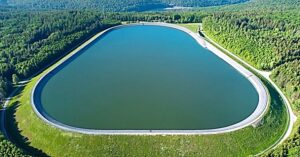Wind, solar and pumped hydro are all we need, and cheaper
Geoff Davies
Wind, solar and pumped hydro energy storage can provide all the electrical energy we need, on demand, cheaply, quickly, with minimal carbon emissions. This is the message that will cut through the energy confusion. The clean energy debate is hampered by widespread lack of awareness of off-river pumped hydro energy storage. It is the third leg of the clean energy tripod. It uses mature technologies and there are abundant suitable sites.

Nuclear, CCS and offsets distract us from the path that will quickly reduce our need for fossil fuels, or for giant, centralised energy generation. We must dismiss them briefly, then focus on the great opportunity the punters need to know about.
Wind and solar are the cheapest ways to generate electricity. Off-river pumped hydro (ORPH) is the cleanest and cheapest way to store electrical energy. It can store much larger amounts of energy than batteries and thus regenerate electricity for longer periods. This makes it the cheapest in terms of energy stored.
Together wind, solar and ORPH can smooth over the fluctuations in both demand for and supply of electricity. If we continue to build them then we can electrify everything, as Saul Griffith urges, thus decarbonising much of our industry and transport. Within a decade we can make major reductions in greenhouse gas emissions -real reductions, not accounting tricks.
Off-river pumped hydro requires two storage ponds, one high and one low, a pipe or pipes to connect them, and a pump/turbine. Water is pumped from the lower to the higher pond whenever electricity is abundant. When electricity is needed, water is run back down through the turbine to regenerate it.
There need be no tunnels. No watercourse is disrupted. There are no toxic chemicals. All the components involve mature technology. Estimates of cost are less than chemical batteries.
Storage ponds are far less complex and expensive than on-river reservoirs. For comparison, there are many irrigation storage ponds in the cotton belt of northern NSW. They commonly have an earthen wall perhaps 4 m high. A pond of 700 m across might have a capacity of 1-2 Gl (giga-litres). With a fall of, say, 300 m from an upper pond to a lower pond, a 2-Gl pond could supply 400 MW of electric power for around 3-4 hours.
This compares with the projected peak power capacity of around 2 GW (gigawatts) for Snowy 2.0. So five or so of these medium-scale storages could match the output of Snowy 2.0.
ORPH ponds might have more robust concrete walls rather than earthen walls, but being relatively flat allows walls to be low, and low walls are much less expensive. Such systems could start operating sooner and for much lower cost.
Snowy 2.0 is not the best way to go about pumped hydro, and it distracts from the full potential of ORPH. Snowy 2.0 is not off-river. Like all of snowy hydro, it is on-river, with huge dams interrupting natural flows. It requires 17 km of giant tunnels, is slow to build with many delays already, very expensive with major cost-overruns already, polluting of a national park, too far from big cities and requiring expensive new grid connections.
Several ORPH projects exist or are underway, mainly state-sponsored, but one rarely hears about them in mainstream political discussion. Examples are the Shoalhaven scheme near Nowra and the Kidston project in QLD, each around 250 MW peak regeneration capacity.
Topographic surveys by researchers at Melbourne University and the ANU have identified hundreds of potentially suitable locations, many of them close to potential grid connections. A moderate number of medium-scale installations could stabilise the grid and cover extended periods of low generation.
Such a system would not be hostage to limited supplies of exotic minerals, which would be freed up for use in batteries where really needed. For stationary energy storage, ORPH can do the heavy lifting, literally. Batteries can supplement and complement, providing for smaller installations and for high-speed response if and when needed. ORPH would remove the need for gas peaking plants to cover high-demand periods, as it can start generating within minutes.
Energy storage allows generation capacity to be used more efficiently, as high-demand periods can be covered with stored energy. Without storage, conventional fossil fuel plants must have a capacity to cover high-demand periods, and much of this capacity is idle during low demand periods. With storage, generation capacity can be lower, closer to average demand.
Since both demand and supply (by wind and solar) are variable, the notion of ‘base-load power’ is irrelevant.
All the aging fossil-fuel plants will need replacing anyway and wind, solar and ORPH are the most cost-effective replacements, even before the big bonus benefits of eliminating carbon emissions and local toxic pollutants and stimulating our transition to fully clean energy and industry.
A completely clean, stable and abundant electricity supply is thus feasible using existing, mature technologies and costing less than fossil or nuclear options. We need to cut through all the distraction and confusion put about by the fossil fuel and nuclear obstructors and get this simple message to voters and candidates. With fossil or nuclear we pay extra to trash the planet. With wind, solar and ORPH we can save money and the world simultaneously.



























